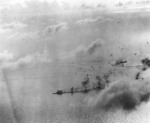Chiyoda
| Country | Japan |
| Ship Class | Chitose-Class Light Carrier |
| Builder | Kure Naval Arsenal |
| Laid Down Date | 26 Nov 1934 |
| Launch Date | 29 Nov 1936 |
| Commission Date | 25 Jul 1938 |
| Sunk Date | 25 Oct 1944 |
| Displacement | 11,400 tons standard; 15,500 tons full |
| Length | 632 feet |
| Beam | 68 feet |
| Draft | 25 feet |
| Machinery | 4 boilers, 2 geared steam turbines, 2 shafts |
| Power Output | 56,800 shaft horsepower |
| Speed | 29 knots |
| Range | 11,810nm at 18 knots |
| Crew | 785 |
| Armament | As tender: 4x12.7cm/40 Type 89 guns, 12x25mm Type 96 anti-aircraft guns; as carrier: 8x12.7cm/40 Type 89 guns |
| Aircraft | 30 operational, 0 in reserve |
| Recommissioned | 21 Dec 1943 |
| Flight Deck | 180x23m |
Contributor: C. Peter Chen
ww2dbaseCarrier Chiyoda began as a seaplane carrier. Between 15 Dec 1938 and 15 Nov 1939, she was commanded by Captain Tomeo Kaku. On 30 Jun 1942, due to the loss of carriers at the Battle of Midway earlier that month, Japanese leadership decided that Chiyoda and her sister ship Chitose were to be converted to light carriers, which was done between Mar and Dec 1943. At the Battle off Cape Engaño on 25 Oct 1944, at 1655 hours, she sank after being hit by many shells from American heavy cruiser USS Wichita's 8-inch guns. She was lost with Captain Eiichiro Jyo and all hands, the only large vessel in WW2 to suffer such total loss.
ww2dbaseSource: Wikipedia.
Last Major Revision: Apr 2009
Light Carrier Chiyoda Interactive Map
Photographs
 |  |
Chiyoda Operational Timeline
| 25 Jul 1938 | Chiyoda was commissioned into service. |
| 25 Oct 1944 | Off northeastern Luzon, Philippines, aircraft from US Navy Task Force 38 attacked the Japanese carrier force consisted of fleet carrier Zuikaku and light carriers Zuiho, Chitose, and Chiyoda in the Battle off Cape Engaño. The Japanese force was escorted by two battleship-carrier hybrids (Hyuga and Ise; aircraft-less on this date), three light cruisers (Oyodo, Tama, and Isuzu), and nine destroyers at about 0830 hours, 26 minutes after those planes were detected by Zuikaku's radar. The overwhelmingly larger American force, under Admiral William Halsey, centered around fleet carriers USS Lexington, USS Intrepid, USS Essex, USS Franklin, USS Enterprise, further bolstered by a great many light carriers, battleships, cruisers, and destroyers. Zuikaku was damaged by skilled damage control teams extinguished the fires and corrected the listing by 0850 hours. Chitose was fatally damaged by the first attack wave, sinking at 0937 hours. At 0953 hours, a second attack wave struck, fatally damaging Chiyoda, leaving her dead in the water to be sunk by American destroyers later at 1655 hours. The second wave also damaged Zuiho's flight deck, the last functional flight deck of Vice Admiral Jisaburo Ozawa's force; Japanese combat air patrol planes in the air would need to ditch when they ran out of fuel. At 1032 hours, Ozawa transferred his flag from the damaged Zuikaku to Oyodo. At 1308, the Japanese sighted an incoming third wave of American aircraft. Six torpedoes struck Zuikaku, causing massive flooding and several fires in the hangar; the commanding officer addressed the surviving crew, ordered the lowering of the ensign, and gave the abandon ship order at 1358 hours; Zuikaku sank by the stern at 1414 hours. Zuiho suffered two torpedo, two bomb hits, and a great many near-misses during the third attack wave, and she was dead in the water at 1445 hours. At 1455 hours, a fourth wave struck, sealing the doom of Zuiho with ten near-misses, leading to Zuiho's commanding officer giving the abandon ship order; she sank at 1526 hours. |
Please consider supporting us on Patreon. Even $1 per month will go a long way! Thank you. Please help us spread the word: Stay updated with WW2DB: |

» Kaku, Tomeo
» Kodaira, Yoshinao
Event(s) Participated:
» Battle of Hainan
» Winter Offensive
» Philippines Campaign, Phase 1, the Leyte Campaign
Document(s):
» Japanese Aircraft Carrier Functions
» Japanese Aircraft Carrier Operational Status By Month
» Japanese Aircraft Carrier Specifications
» Japanese Aircraft Carrier Time Operational
Partner Sites Content:
» Chiyoda Tabular Record of Movement
- » 1,183 biographies
- » 337 events
- » 45,131 timeline entries
- » 1,249 ships
- » 350 aircraft models
- » 207 vehicle models
- » 376 weapon models
- » 123 historical documents
- » 261 facilities
- » 471 book reviews
- » 28,438 photos
- » 365 maps
Lt. Gen. Lewis B. "Chesty" Puller, at Guadalcanal
Please consider supporting us on Patreon. Even $1 a month will go a long way. Thank you!
Or, please support us by purchasing some WW2DB merchandise at TeeSpring, Thank you!